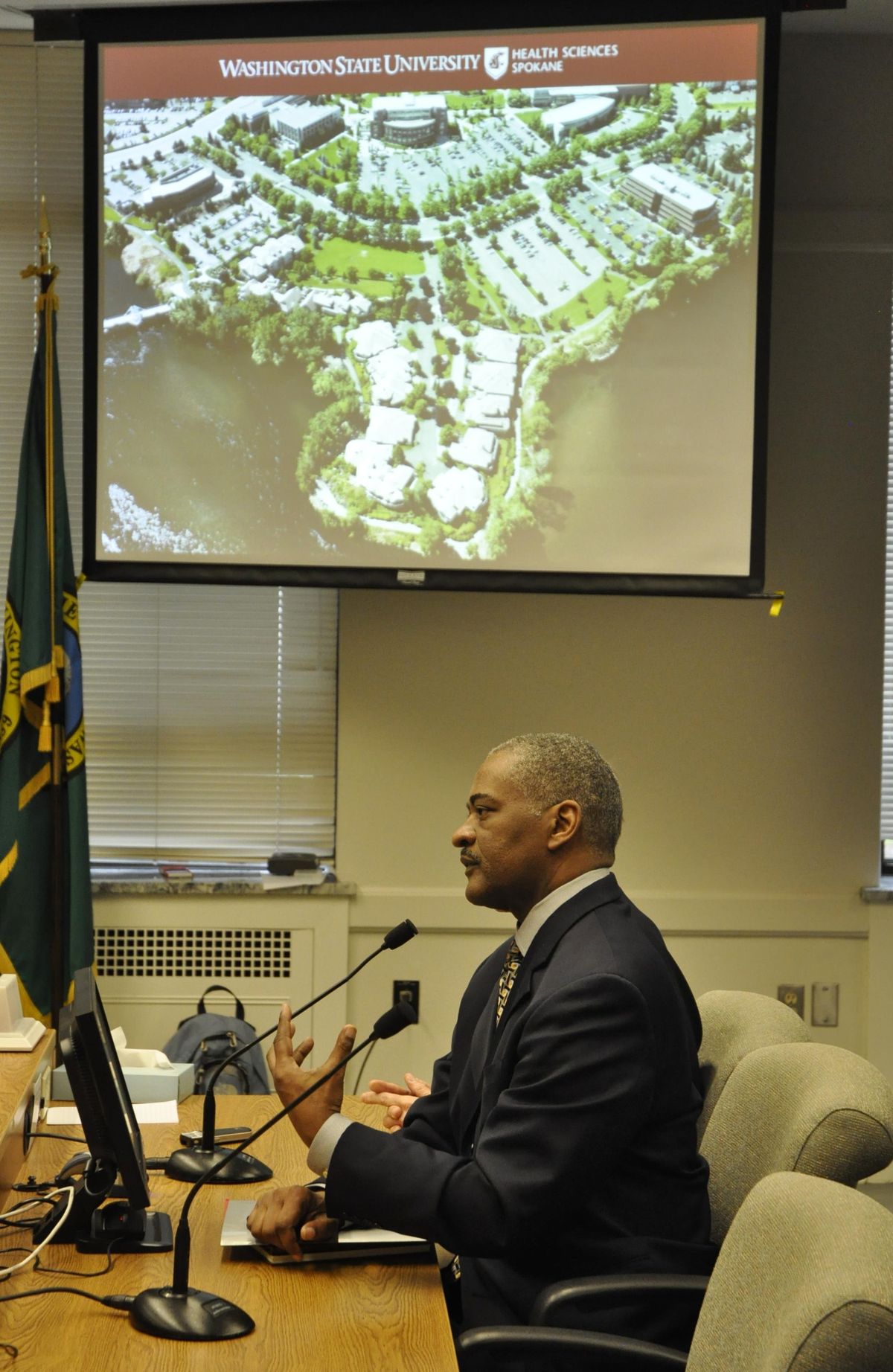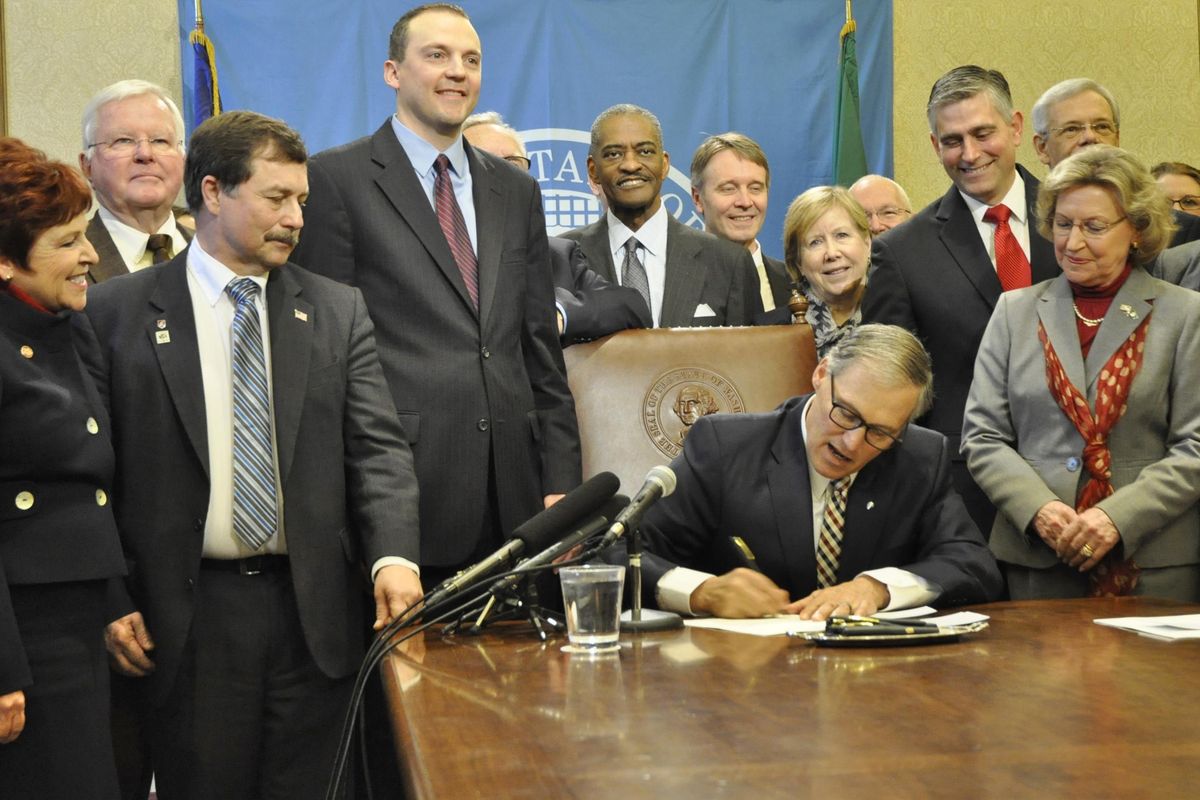100 years after legislators barred WSU from starting medical school, WSU’s first class of medical students start work in Spokane
Gov. Jay Inslee shakes hands with WSU President Elson Floyd in April 2015 after the signing of the bill giving the university the legal authority to start its own medical school. (Jim Camden / The Spokesman-Review)
When Washington State University opens the doors to its first class of medical students Wednesday, many of them won’t know – and most may not care – about the political maneuvering that first made this day difficult, and then made it possible.
Just over two years ago, it wouldn’t even have been legal for WSU to have its own medical school.
A 1917 law gave the University of Washington the sole authority to operate a medical school in the state, a result of the Legislature settling a “turf war” over academic majors between the schools in Seattle and Pullman. The state had only so much money to spend on its public colleges, and wasn’t about to pay for duplicating expensive programs. UW got architecture, law, journalism and aeronautical engineering; what was then Washington State College got veterinary medicine, almost anything related to agriculture and “rural life.”
A medical school, when one was built, would be exclusively the right of UW, the law said in another section. That didn’t happen for another 28 years, when the Legislature came up with $3.7 million for the university to set up schools of medicine and dentistry as World War II was ending.
That law stayed on the books, and UW School of Medicine expanded as Washington grew. The fact that it was the only medical school at a public university in Washington probably didn’t seem so strange because the nearby states of Wyoming, Alaska, Montana and Idaho had none at all. In the 1960s, the university set up a cooperative arrangement with those states to educate their med students as well in a program called WWAMI, which takes its acronym from the first letters of the five states.
WWAMI had a presence in Pullman for years, but in the 1990s, local leaders began angling for expanded medical education in Spokane to complement one of the city’s biggest growth industries, health care. One problem was they didn’t have a place to put it.
Today’s new medical students may look around and marvel at the grassy hillsides and river walkways of Riverpoint campus, but should realize that 25 years ago that was just a stretch of debris-strewn rail lines between Gonzaga University and Trent Avenue. The area began to change when local leaders persuaded the Legislature to build the Spokane Intercollegiate Research and Technology Institute, which was a cooperative effort between local public and private colleges. The state later built classrooms nearby for WSU and Eastern Washington University.
In 2006, WSU broke ground on a new Intercollegiate College of Nursing at Riverpoint, moving the coordinated nurses training from its old quarters near Spokane Falls Community College.
Five years later, city leaders had a new ask: a building for medical students at Riverpoint. While it was often called a “med school” by locals, its official title was the Biomedical and Science Center.
That was late 2011. The state still was trying to recover from the recession, and the $70 million structure wasn’t in then-Gov. Christine Gregoire’s early budget proposal. But WSU President Elson Floyd made the hard sell and Spokane had some powerful allies in the Legislature, including then-Senate Majority Leader Lisa Brown, a Spokane Democrat whose district included Riverpoint. The final capital budget had $35 million for the building, with the understanding that the next year, the state wouldn’t walk away from the project halfway through, and the rest of the money would be in the 2013-15 capital budget. It was.
Brown retired at the end of 2012 and took the job of chancellor at WSU-Spokane.
Before that building was complete, however, friction between WSU and UW got hot enough to start a brush fire.
For the 2013 school year, UW was given enough money to send 20 medical students to WWAMI in Spokane; it sent 17. Floyd said UW didn’t recruit enough students to fill the slots. UW President Michael Young said the school could only find 17 students who wanted to go to Spokane. Floyd countered that if UW wouldn’t cooperate, WSU would start its own medical school.
“Good luck,” said Young, adding that Floyd didn’t know how a medical school is run. What came to be known as the medical school Apple Cup was on.
Gov. Jay Inslee – a Husky alum married to a Cougar alum – tried to stay out of the rivalry, and wrote a budget in late 2014 that didn’t have new money for either medical school. He let the universities make their pitches to the legislative committees that would write the final budgets.
Although UW had plans to eventually have a new class of 80 med students each year at WWAMI in Spokane, it was Floyd who put on the full-court press starting in January 2015 for WSU to have its own medical school. He made repeated trips to Olympia, wowed lawmakers during committee hearings and charmed them in private meetings. He slowly made inroads into the strong support UW traditionally has from Seattle-area legislators, and his pitch for a new school with a different system to train doctors for family medicine and rural practice resonated with those from rural areas who were seeing a shortage of health care practitioners. It would be part of an overall strategy that included more medical residencies in rural hospitals and clinics and more financial aid for students who would practice in those areas.
Floyd also had some powerful allies like Mark Schoesler, the Ritzville Republican whose district includes the Pullman campus and parts of Spokane County and who by then was Senate majority leader.
When the Legislature held hearings on rewriting the 1917 law, UW said it didn’t object to the change as long as money for the new school didn’t come out of the WWAMI budget and hurt that program.
In March 2015, the Legislature passed a bill that gave WSU the legal authority – although not the money – to have its own medical school. In legislative budgets that were released a few weeks later, UW was allotted $9.7 million to expand WWAMI in Spokane and WSU was given $8 million over the next two years to cover the costs of seeking accreditation and getting ready for its first class of med students.
On April 1 of that year, Floyd, Brown and a group of smiling legislators stood behind Inslee as he signed the WSU medical school authorizing bill. There were cheers all around, but the loudest were for Floyd.
Two months later, university officials announced Floyd was taking a leave of absence to battle colon cancer. He would lose that battle before the end of the month.
In what may have been the easiest decision of the 2015 session, the Legislature moved within days to name the new medical school for Floyd.
UW would later break off its arrangements with WSU for WWAMI and enter into an agreement with nearby Gonzaga University. The competition for funding has decreased slightly as the need for doctors the two schools can produce has increased. The state’s 2017-19 operating budget has a total of $15 million for medical education in Spokane between the two schools.
Based on plans for the two programs, Spokane could go from having no medical school at the beginning of this decade to at least 240 med students in two schools at the end of it.


